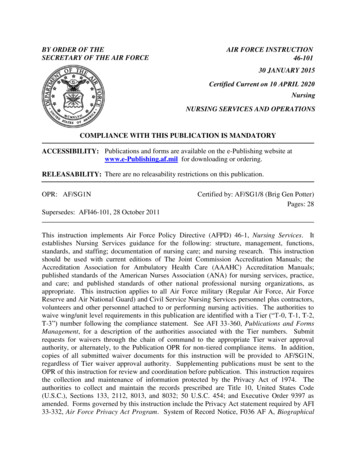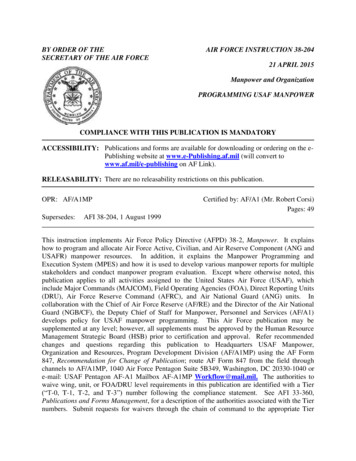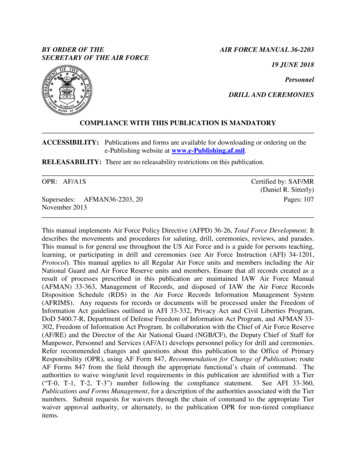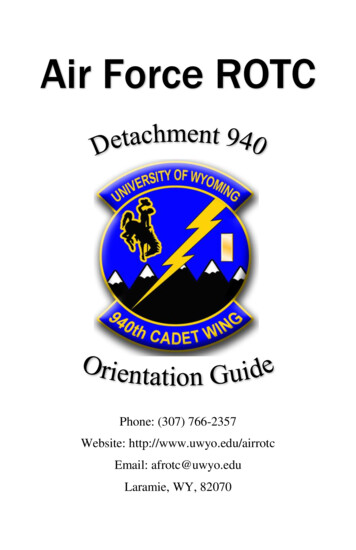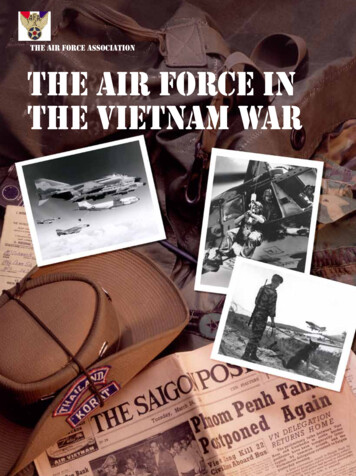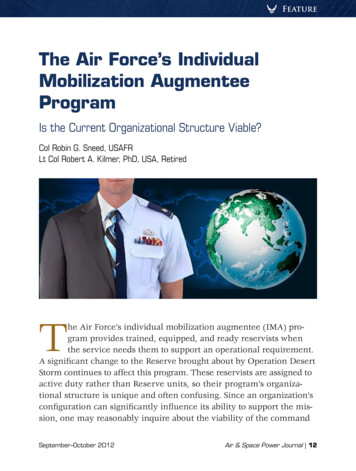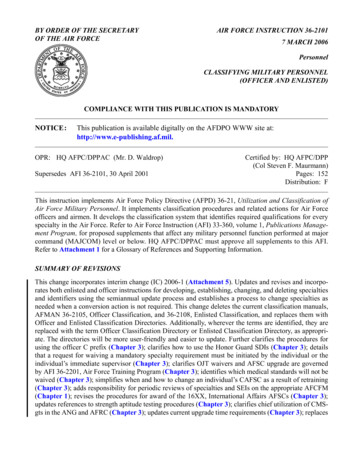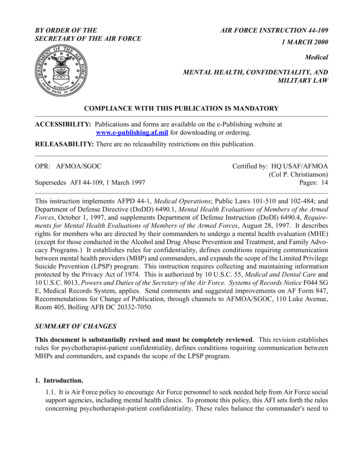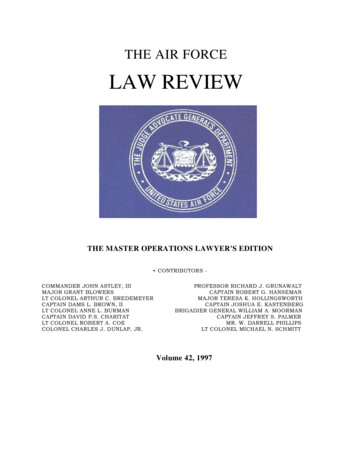
Transcription
THE AIR FORCELAW REVIEWTHE MASTER OPERATIONS LAWYER'S EDITION- CONTRIBUTORS COMMANDER JOHN ASTLEY, IIIMAJOR GRANT BLOWERSLT COLONEL ARTHUR C. BREDEMEYERCAPTAIN DAMS L. BROWN, IILT COLONEL ANNE L. BURMANCAPTAIN DAVID P.S. CHARITATLT COLONEL ROBERT A. COECOLONEL CHARLES J. DUNLAP, JR.PROFESSOR RICHARD J. GRUNAWALTCAPTAIN ROBERT G. HANSEMANMAJOR TERESA K. HOLLINGSWORTHCAPTAIN JOSHUA E. KASTENBERGBRIGADIER GENERAL WILLIAM A. MOORMANCAPTAIN JEFFREY S. PALMERMR. W. DARRELL PHILLIPSLT COLONEL MICHAEL N. SCHMITTVolume 42, 1997
THE AIR FORCELAW REVIEWCONTENTSFOREWORD .ivBrigadier General William A. Moorman, USAFARTICLESDisciplining the Force -Jurisdictional Issues in the Joint and Total Force . 1Major Grand Blowers, USAFCaptain David P.S. Charifat,USAFJAGSDeployed: Environmental Law Issues. . 19Lietitenant Colonel Anne L. Buman, USAFMajor Teresa K.HuCEing worth,USAFFighter Ops for Shoe Clerks . 49Lieufewant Colonel Robert A. Coe, USAFLielatenant Colonel Michael N. Schrnitr, USAFInternational Agreements: A Primer for the Deploying Judge Advocate . I 0 ILieutenant Colond Arthur C. Bredemeyer, USAFThe Law of the Sea and Naval Operations. . 1 19Commander John AstIey III, USCGLieutenant Colonel Michael N: Schmirr, USAFTaming Shiva: Applying International Law to Nuclear Operations. 157Colonel Charles J. Dunlap, Jr., USAFThe Realities and Legalities of Information Warfare . 173Captain Robert G. Hansemarz, W A F
European ColIective Security in the Next Millenium . 20 3Captain Davis L. Brown, I., USAFClaims Encountered During an Operational Contingency .227Captain Jefrey S.Palmer, USAFThe JCS Standing Rules of Engagement: A Judge Advocate" Primer . 245Professov Richard J. GrunawaltFiscal Law Constraints Upon Exercise-Related Activities . 259Mr. W. D awdlPhillipsThe Legal Regime for Protecting Cultural Property DuringAnmed Conflict .277Captain Joshua E. Knstenberg, USAF
THE AIR FORCE LAW REVIEWAFPAM 51-106The Air Force Law Review is a publication of The Judge Advocate General, United States AirForce. It is published semiannually by the Air Force Judge Advocate General School as aprofessional legal forum for articles of interest to military and civilian lawyers. The Reviewencourages frank discussion of relevant legislative, administrative, and judicial developments.The opinions expressed in this publication are solely those of the individual authors. The articlesdo not in any way promulgate policies or state the official opinions of The Judge AdvocateGeneral, USAF, or the Department of the Air Force. Other departments and agencies of the UnitedStates Government do not necessarily concur with the views expressed in the Review.The Review solicits contributions from its readers. Information for contributors is provided on theinside back cover of this issue.Readers who desire reprint permission or further information should contact the Editor, The AirForce Law Review, Air Force Judge Advocate General School (CPD/JAL), 150 Chennault Circle,Maxwell Air Force Base, Alabama 36112-6418. Official governmental requests for free copies, notunder the depository program, also should be sent to the above address.Cite this Law Review as 42 A.F.L. REV. (page number) (1997).Distribution. The Review is distributed to Air Force judge advocates. In addition, it reaches othermilitary services, law schools, bar associations, international organizations, foreign governments,federal and state agencies, and civilian lawyers.Bound Copies. Readers should retain individual copies of the Review. The publisher does notsupply bound volumes.
THE AIR FORCELAW REVIEWVOL. 421997CONTENTSFOREWORD . . ivBrigadier General William A. Moorman, USAFARTICLESDisciplining the Force - Jurisdictional Issues in the Joint and Total Force . 1Major Grant Blowers, USAFCaptain David P.S. Charitat, USAFJAGS Deployed: Environmental Law Issues. 19Lieutenant Colonel Anne L. Burman, USAFMajor Teresa K. Hollingsworth, USAFFighter Ops for Shoe Clerks. . 49Lieutenant Colonel Robert A. Coe, USAFLieutenant Colonel Michael N. Schmitt, USAFInternational Agreements: A Primer for the Deploying Judge Advocate . 101Lieutenant Colonel Arthur C. Bredemeyer, USAFThe Law of the Sea and Naval Operations. . 119Commander John Astley III; USCGLieutenant Colonel Michael N Schmitt, USAFTaming Shiva: Applying International Law to Nuclear Operations. 157Colonel Charles J Dunlap, Jr., USAF
The Realities and Legalities of Information Warfare . 173Captain Robert G. Hanseman, USAFEuropean Collective Security in the Next Millenium . . 201Captain Davis L. Brown, II, USAFClaims Encountered During an Operational Contingency . 227Captain Jeffrey S. Palmer, USAFThe JCS Standing Rules of Engagement: A Judge Advocate's Primer . . 245Professor Richard J. GrunawaltFiscal Law Constraints Upon Exercise-Related Activities . . 259Mr. W Darrell PhillipsThe Legal Regime for Protecting Cultural Property During Armed Conflict . . 277Captain Joshua E. Kastenberg, USAF
THE AIR FORCE LAW REVIEWMAJOR GENERAL BRYAN G. HAWLEY, USAFThe Judge Advocate General of the Air ForceMAJOR GENERAL ANDREW M. EGELAND, JR., USAFThe Deputy Judge Advocate General of the Air ForceCOLONEL JACK L. RIVES, USAFCommandant, Air Force Judge Advocate General SchoolLIEUTENANT COLONEL PATRICK W. LINDEMANN, USAFEditor, The Air Force Law ReviewMAJOR TERESA K. HOLLINGSWORTH, USAFCAPTAIN RICK A. BECKER, USAFRSTAFF SERGEANT ELIZABETH A. SMITH, USAFAssociate EditorsEDITORIAL BOARDCOLONEL JACK L. RIVES, USAF, of GeorgiaChairpersonLIEUTENANT COLONEL R. PHILIP DEAVEL, USAF, of MississippiLIEUTENANT COLONEL DENNIS W. SHEPHERD, USAF, of KentuckyLIEUTENANT COLONEL ANNE L. BURMAN, USAF, of IllinoisMAJOR PAMELA D. STEVENSON, USAF, of IndianaMAJOR MICHAEL A. RODGERS, USAF, of OhioMAJOR LAUREN K. HEMPERLEY, USAF, of TexasMAJOR VICKIA K. MEFFORD, USAF, of CaliforniaMAJOR ANN D. SHANE, USAF, of North CarolinaMAJOR STEVEN E. WALBURN, USA, of TennesseeMAJOR DAVID C. WESLEY, USAF, of AlabamaMAJOR SCOTT R. MARTIN, USAF, of FloridaMAJOR GARY F. SPENCER, USAF, of AlabamaMAJOR TIMOTHY G. BUXTON, USAF, of Pennsylvania and ColoradoMAJOR BARBARA J. ZANOTTI, USAF, of West Virginia, Florida, and ColoradoMAJOR PHILIP G. MOWRY, USAF, of OhioMAJOR KIRK L. DAVIES, USAF, of UtahW. DARRELL PHILLIPS, of Alabama and Texas
FOREWORD[We are honored to celebrate our second theme edition of The Air Force Law Review inOperations Law with this special introduction from Brigadier General William A. Moorman. /*/General Moorman shares his personal experiences about his and other JAGS' involvement inOperations Law and discusses the recent JAG FLAG exercise].Shortly after my arrival to Twelfth Air Force as the Staff Judge Advocate in the summerof 1989, I discovered that I was also the USSOUTHAF Staff Judge Advocate. USSOUTHAFwas the air component of US SOUTHCOM, one of the unified commands. Several months later,I began to explore a series of plans for contingencies in Panama. My staff became more and moreengaged in operational concerns as the situation with U.S. Forces in Panama steadily deterioratedunder Manual Noriega's dictatorship.As we moved steadily toward intervention, I immersed myself, for the first time in myeighteen year career, in the concepts of Rules of Engagement, the Law of Armed Conflict, targetingissues, handling of prisoners and detainees, and a host of other potential problems that were likely toaccompany the execution of our plan to restore democracy to Panama, while protecting US citizenspresent in that country. This was to be our first real involvement, as judge advocates, in any kind ofcombat since Vietnam had drawn to a close some 15 years earlier. I knew that we were not wellprepared to be active assistants to warfighters. Also, I discovered that many operators did not fullyunderstand the range of possible options available to them within the law ofarmed conflict and the body of other law which potentially affected Air Forceoperations.To my surprise, many planners were operating under a misperception of the legal constraints placedon them. Thus, I found that the work of the judge advocate in planning OPERATION JUST CAUSErevolved around explaining to planners and other operators that they had more, rather than fewer,options in planning the air campaign. It appeared that in the years following Vietnam, we had subtlycommunicated to a generation of Air Force personnel that air operations must have as their centralplanning focus minimizing collateral damage. It became the frequent role of the judge advocate toexplain that operational necessity was the primary imperative. After our eventual launch ofOPERATION JUST CAUSE in the middle of the night on 19/20 December 1989, and the successfuloperations which followed, it was time for judge advocates to consider the future.Against the backdrop of General Noriega's arrest and transport to Miami for eventual trial, amember of the Chairman's Legal Advisor's staff in the Joint Chiefs of Staff office, Colonel MikeNye, and I delivered a presentation at The Judge Advocate General's Worldwide Conference atHomestead AFB in January 1990. My appearance in BDUs, designed to emphasize our involvementin operations, was greeted with mild amusement. Our thesis that judge advocates must begin toprepare for involvement in contingency operations in an increasingly more complex world wasgreeted with polite, but somewhat skeptical, attention. We had no way of knowing that SaddamHussein would make us look like we had clear insight into the future less that eight months laterwhen his forces invaded Kuwait.In the years since OPERATION JUST CAUSE, we made tremendous progress as a Departmentin preparing judge advocates and paralegals to cope with the challenges provided by what we
now call operations law. We established superb courses at the Air Force Judge AdvocateGeneral School, took advantage of operations law educational opportunities at the Army andNavy JAG Schools, and began to establish a solid base of operations law related scholarlyarticles by judge advocates who had been involved in operations. But despite the tremendousimprovements we made, we still lacked the appropriate vehicle for translation of theory,recorded lessons learned, and course work into field application.While I was the Staff Judge Advocate for USAFE from 1993 to 1995, we set in motion aneffort to establish yet another approach to teach operations law-related topics to those whowould be involved in the growing number of contingencies we then faced in Europe. Althoughwe attempted to put a practical edge on our effort, we did not achieve everything we needed todo. Finally, at Air Combat Command, we decided to create a training program which wouldactually provide those, who were most likely to be tasked, with the practical tools andexperience they needed in order to be immediately effective in a deployed environment.Our charter was to design a week-long training exercise which would do the following: First, ithad to employ judge advocate and paralegal teams. These teams were to be comprised ofpeople assigned to the same base with the idea that, if called upon, they would go to acontingency together. Second, it would have a field training component to prepare the judgeadvocates and paralegals to operate in conditions they could expect to find in a contingencylocation. I believed it was important for our teams to know how to handle everything frompitching a tent to dealing with possible terrorist threats. Third, the instruction would beprovided by both judge advocates and paralegals since both groups had much to contribute.Fourth, the scenarios employed in the field training portion would have to be sufficientlydemanding to ensure that taskings could not be accomplished without teamwork. I wanted thetraining to emphasize that judge advocates and paralegals each bring unique skills to theoperational environment and that the full potential of each must be realized in order to besuccessful. Finally, I wanted to make sure that the field training was interactive. This meantthat a cadre of experienced judge advocate and paralegal controllers would act as both criticsand coaches.
The First JAG FLAG ExperienceWe began the effort to plan this new departure with the assistance of many peoplewho had previously deployed. We asked for their ideas concerning those things they wishthey had known before they were actually deployed. The assistance of those who had "beenthere, done that" was absolutely essential to making what we had in mind relevant to futureoperations. Next, we convened a working group of prior deployers.At some point in the planning, we selected the name JAG FLAG for our training concept.We wanted to clearly convey to those who heard about our training program that it shared acommon set of goals with the major FLAG exercises which inspired its name. We wanted toemulate RED FLAG where Air Force pilots and their direct support crews go to hone theirwarfighting skills against the best the Air Force has to offer in RED force opposition. Wewanted to emulate the training experience which others have encountered in the BLUEFLAG exercises which have become key to joint warfighting at the theater campaign level.Our training concept was fairly straightforward. We assembled a team of instructors fromacross the Air Force, but mainly from ACC. They were selected based upon their real-worldknowledge and their ability to clearly convey what they knew to others. They wereresponsible for building the course materials and the training vignettes to be used forapplications training. They reviewed the inputs from others who had deployed, applied theirown experiences, reviewed all of the materials available, and designed a comprehensivetraining package. An added objective was to insure that those judge advocate and paralegalteams we trained would be equipped with materials and experiences which would help thembuild more robust training scenarios for their home station exercises.On 19 May 1997, we assembled the first class for JAG FLAG. However, the trainingactually began before the teams arrived at Nellis AFB. Some weeks prior to their arrival, webegan loading data peculiar to our training scenario country (simply named HOST) intodatabases which already existed on FLITE. These databases could be accessed by anyonewith enough foresight to appropriately search for data prior to departure for the deployedtraining location. Among the items loaded were a Status of Forces Agreement, a ProjectPitfall letter, and other materials concerning the country, its customs, and its government.Few of our participating teams thought to look for this information on WEBFLITE prior totheir arrival at Nellis, but they all came away knowing that WEBFLITE contains a wealth ofinformation which can start deployers out well, from the moment they are alerted.Teams, one from almost every ACC base, one from the Air National Guard, and one fromthe Reserves, were told to arrive with the materials they needed to deploy and operate in arelatively bare base location. They arrived with BDUs, gas masks, laptops and portable printers,and written materials which they thought essential. Most brought a similar suite of gear, althoughat least one experienced team thought to bring air mattresses for the cots they would sleep on fortheir two deployed nights. The final class make-up was nineteen JAG/Paralegal teams, twelvecontrollers, and an adjunct faculty of six.Classroom work occupied the first two days. Each block of instruction was designed to provide theteams with specific information which would meet our training objectives. Our aim in thisinstruction was to keep the information practical and useful to both the JAG and paralegal. Inaddition to the legal topics, we provided briefings on the practical concerns of setting up a legal
office and how to work together as a team. The briefings were designed to tie into the actual fieldexercise that was planned for the second two days. In this manner, we would encourage theparticipants to actually apply what had been briefed.The field exercise began the morning of the third day. The teams were processed through adeployment line, received chemical refresher training, and carried their gear to the deployment site.The deployment site, Camp Cobra, is about 5 miles from Nellis and is used for their support groupexercise training. The camp consists of a few permanent buildings (these were used for the teamsto set up their legal offices) and some frames over which tents can be placed. There is no airconditioning, heat or shower facilities.The first task on reaching the deployment site was for the teams to set up their living and workingspaces. After this, the teams were presented with the first training vignette (scenario). Each teamwas required to work on its own in addressing the problems raised in every vignette. They could usetheir own resources or, if they had such a capability, use phone line connections to access FLITE.Three issues that surfaced early on in the planning process were how to keep some measure ofcontrol over this potential gaggle, how should the vignettes be distributed and, how would theprocess actually work without other functional areas to react upon/with? We solved the first twoproblems through the use of what we called Observer/Controllers (O/Cs) for each team. The teamswere numbered 1-19 and then divided into groups of three with one group of four. Each member ofthe Exercise Staff was then given the task of serving as an O/C to one group.The O/Cs were critical to the entire deployment experience. Their charter was to deliverthe vignettes; answer questions; monitor progress or the lack thereof; and mentor where needed.Depending on the vignette, the team could be required to provide a simple one-line writtenanswer or to brief a topic. Time limits were placed on some answers. The entire process wascoordinated so that each O/C knew when the next vignette or intelligence report should be given.Teams were left on their own to divide their time, prioritize tasks, and keep track of their work.The lack of other functional experts was an issue without a real solution. If we wantedthe functional experts to serve simply as role players, space and manning would not permit thenumber of different functionals that would have been needed to keep every team working on thesame vignette. While it might have been possible to stagger the vignettes so that each teamwas working on a different vignette, this would still have resulted in a rather significantcommitment of manning and resources, without any real benefit to the non-legal participatingfunctional area. If we wanted the functional to actually participate rather than be role players, weagain ran into the limitations on space. Additionally, the number of people needed to react with19 different legal offices would be enormous. (Not to mention the logistics and financialissues that would need to be resolved!)Our final solution was to press forward. We recognized that the lack of other agencies to react withwould somewhat detract from the realism of the training. However, we worked to design the vignettesto minimize this as much as possible. Also, each vignette requested that, in addition to providingthe answer, the team list what other information they would like to know and what other functionalareas or agencies they should contact.The vignette flow was designed to cover a wide variety of topics. This included: preparing a willand power of attorney; creating a LOAC, Force Protection, and ROE briefing; devising a GeneralOrder-1; advising on several fiscal law/contracting issues; providing legal assistance; answeringmilitary justice questions; applying the SOFA, Project Pitfall and other exercise-created
documents to respond to host country issues; reviewing the exercise ROE and requesting a changeusing the proper format from the Standing Rules of Engagement; and providing advice on targetingissues.The vignettes came from various sources. Some were our contacts with the Army and Navy,USAFE and PACAF; and others were submitted by the various team members. To get a true flavor ofwhat the teams went through, you can visit our website at: http://www.acc.af.mil/ja and review theO/C Handbook. This handbook contains every vignette presented to the teams, and it shows the schoolsolutions and the time flow. The handbook will give you a real appreciation for just what theparticipants faced:While we had prepped the team with two days of briefings, to further assist them in providingresponses to the various vignettes we also provided each team with five diskettes full of talkers,checklists, background papers, and briefings on a myriad of operational topics. Several of the vignetteswere specifically written so that if a team used the information on the diskette, theycould find the answer.The primary goal of the vignettes was to give the participants practical, hands on experience indealing with real world operational issues. Another equally important objective was to task saturateeach team to the point that they could not complete the work unless they worked together as a team. Aswe stated earlier, one of our primary goals was to foster teamwork. We wanted to stretch both the judgeadvocates and the paralegals to use their full capabilities. Some teams quickly caught on, and theparalegal was reviewing the information provided on diskette; finding the appropriate items; reviewingthem; and, putting together a possible response. All of this was done while the JAG was reviewing orseparately preparing an answer to a different vignette. Other teams needed some mentoring from theO/Cs, but all were effectively working together by the end of the deployment.In addition to having to deal with the vignettes and the heat, dust and discomfort of workingin an unfamiliar and uncomfortable environment, we also included such stresses as loss ofpower, simulated shelling, mass casualties (simulated with frightening realism by personnelfrom the Nellis hospital), and a few simulated chemical attacks. The end result was a realisticand demanding environment that had everyone - participants and O/Cs alike - looking forward toENDEX.The fifth and final day of the exercise was devoted to a HOT WASH/ review of the CampCobra vignettes and the end of course critique. The extended period allocated for the HOTWASH - three hours - gave the attendees the opportunity to discuss the vignettes individually;review the school solutions and ask questions.At several points during the exercise we had stressed to the participants that their feedbackwas going to be essential. To improve on the program, we would need their honest assessments.Also, as this was he first time we had attempted such an event, we were genuinely interested intheir views. While the Staff believed the exercise had gone well, no one was prepared for theunanimously positive responses submitted by the participants. While the critiques containedmany suggestions on how to do things differently next time, there was not a single negativecomment about the course concept. Every participant felt that he or she had learned valuablelessons from the training, and gave an unqualified "thumbs-up" to the idea of combining theclassroom training with some hands-on experience.
So, what does all this tell us? First, that through the hard work and effort of many people wesuccessfully met he challenge of joining the classroom and the field. That is not to suggest That wecannot improve. We are already working to incorporate suggestions and improvements that will resultin an even more successful event next year. Second, that this training was an idea whose time hadcome. Participants and SJAs alike agreed that this concept was exactly what was needed to betterprepare our people to deploy. Third, that this training provides great benefit even without the otherfunctional areas involved. While exercising with the other functionals at the base and higher level iscrucial to understanding how JA fits into the process, neither base level nor JCS level events canexpose the participants to more than a small fraction of the legal issues faced by those at JAG FLAG.Where are we going from here? JAG FLAG 98 will, if at all possible, occur. In addition, we arelooking at expanding the concept. We now know it works for our young and less experiencedpersonnel, but they are not always the most likely ones to deploy. Therefore, we are now pursuing thepossibility of holding a SR JAG FLAG for our SJAs and LOMs. For those skeptical about the value ofsuch a program, we too have our concerns. But, remember, just a few years ago most were skepticalabout the value of such training for any judge advocate.While JAG FLAG can be termed a success, it is only the first of many steps that need to be taken. Weneed to get more of our people involved in base level and higher exercises. We need to do more in ourOperational Readiness Inspections than just evaluate how quickly the legal office responds to a LOACinput. We need to do a better job of gathering up and disseminating lessons learned from everydeployment, exercise, and contingency.We are convinced that JAG FLAG is the next logical step in preparing judge advocates andparalegals to operate as a seamless team in any deployed environment. Our materials can be adapted tothe requirements of any MAJCOM, and we encourage you to ask for them.' We also encourage thoseof you who are interested in what we are doing to send us your thoughts on how this field-orientedtraining can be improved. Those of us who have been exposed to the robust wartime/contingencyrequirements for knowledgeable, well-trained, operations-oriented judge advocates and paralegals,know that we have made great progress over the past few years. But, there is much left to bedone.The creation of JAG FLAG is only one further step along a path which we must travel if we are toremain relevant to a smaller Air Force pursuing Global Engagement. Happily, the Department'sstrategic plan, JAG 21st Century, recognizes the importance of operations and our involvement inthem. Operations has become a Major Focus Area and work is underway to develop MinimumEssential Task Lists (METLs) for our involvement in operations. The creation of a separate OperationsLaw function under The Judge Advocate General is another giant step forward. We hope this detailedaccount of the problems and successes we have had with the first JAG FLAG is useful to those of youwith an eye on the future and concerned about our place in that future.Authority to publish automatically expires unless otherwise authorized by the approving authority.Distribution: Active duty Air Force judge advocates; judge advocates of the Army, Navy, CoastGuard, and Air National Guard; law schools; professional bar association libraries. Approximatereaders-per-copy ratio is 4 to 1.* General Moorman is the Staff Judge Advocate, HQ Air Combat Command, Langley AFB,Virginia.1 The information is also available on our website at: http://www.acc.afmil/ja/jagflag.html.
Disciplining The Force Jurisdictional Issues In TheJoint And Total ForceMAJOR GRANT BLOWERS, USAF /*/CAPTAIN DAVID P.S. CRARITAT, USAF /**/I. INTRODUCTIONA member of the U.S. Air Force serving as part of a joint task force (JTF) commandedby an Army general commits a serious violation of the Uniform Code of Military Justice(UCMJ). The JTF commander wants to convene a general court-martial. An Air NationalGuard officer flying a refueling mission as part of a joint campaign in Europe violates theUCMJ. The Air Component Commander of the Unified Command wants to convene aspecial court-martial. An Air Force airman stationed at a provisional unit in Saudi Arabiacommits an offense that merits nonjudicial punishment. The unit commander wants himpunished. These types of disciplinary situations have become common in today's Air Force.U.S. armed forces, including Air Force personnel, are currently deployed andemployed all over the globe. They are involved in almost every conceivable type of operation,from standing forces in Western Europe and the Pacific to JTFs in such divergent places asSaudi Arabia, Bosnia, and the Olympic Games in Atlanta. In many instances, deployedforces include combinations of active, Reserve, and National Guard forces. As the StaffJudge Advocate (SJA) for the JTF, Air Component, or provisional unit commander above, ajudge advocate (JAG) must understand the intricacies of proper disciplinary authority in suchsituations and be' able to provide guidance and legal advice to his commander.Maintaining discipline and esprit de corps has always been essential to efficient military operations.Experience has taught us that, in joint and total force operations, maintaining the good order, morale,and discipline of the force is even more crucial to success of the mission than during peacetime. JAGs,however, have come to learn that disciplining such strangely structured, multi-service organizations asJTFs, Unified Commands, and provisional units presents a unique set of problems with regard to properlegal authority to impose nonjudicial punishment under Article 15 o
THE AIR FORCE LAW REVIEW AFPAM 51-106 The Air Force Law Review is a publication of The Judge Advocate General, United States Air Force. It is published semiannually by the Air Force Judge Advocate General School as a professional legal forum for articles of interest to military and civilian lawyers.


